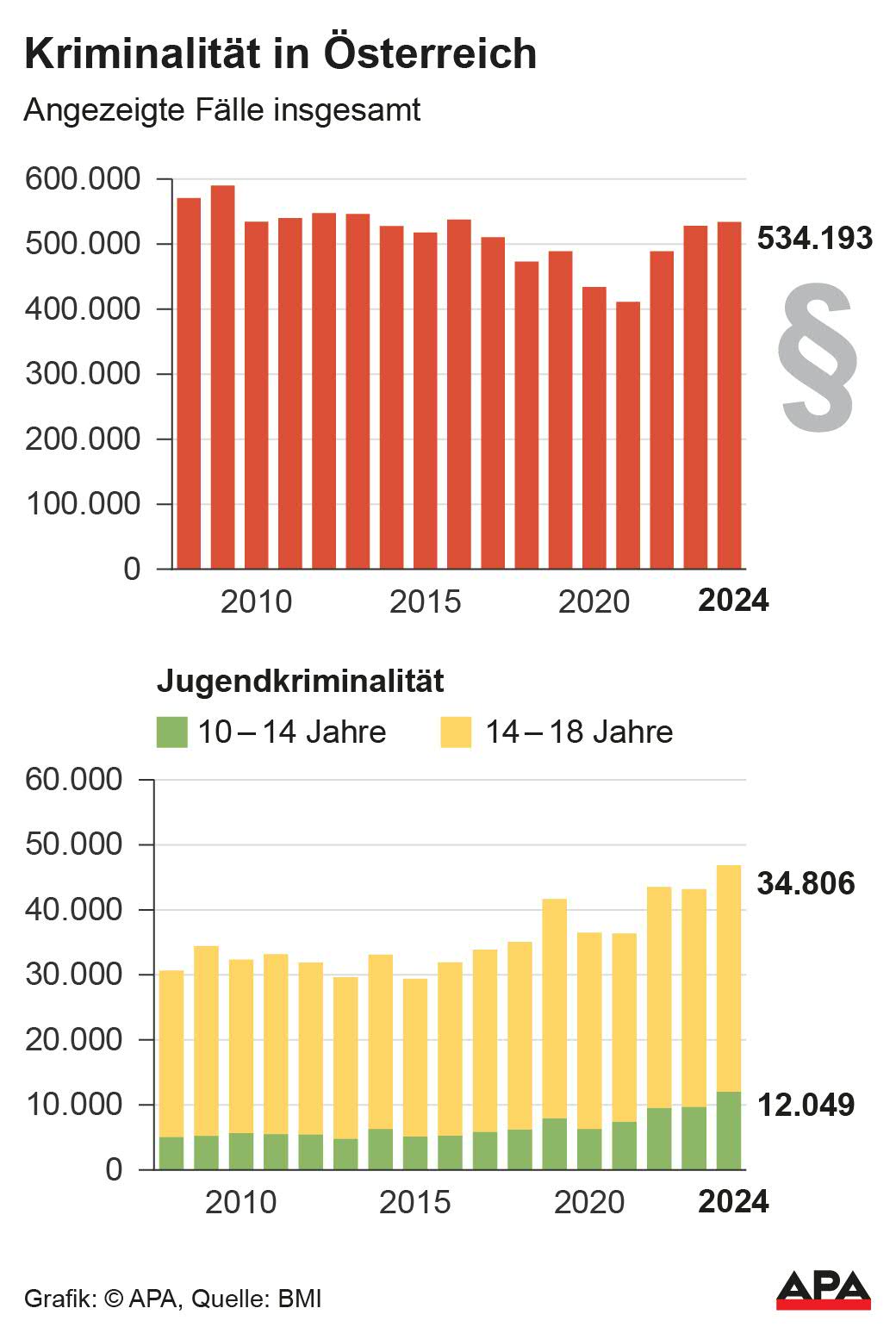Offenders Are Getting Younger: Shocking Figures on Youth Crime in Austria

In the evaluation of the 2024 police report statistics, a "massive increase in juvenile delinquency" was evident, as Interior Minister Gerhard Karner (ÖVP) explained at a press conference on Monday in Vienna.
Crime statistics show strong increase in offenses by juveniles
Karner described this area as a "problem child" because the perpetrators are also getting younger. Reports with suspects aged ten to 14 have doubled in recent years. In 2024, there were 12,049 reports in this category.
The proportion of non-Austrian suspects in this area is 48 percent. Reports with Syrian suspects have "practically tenfold" from 150 in 2020 to around 1,000 last year, said Karner. He cited stopping family reunification as the most important measure, as the proportion of Syrian citizens would have accounted for 90 percent here, the minister said.
Underage "system breakers" as a major problem
According to Dieter Csefan, head of the department for combating organized and general crime at the Federal Criminal Police Office (BK) and the newly established task force for combating juvenile delinquency last year, there is a particular problem with so-called system breakers: These are underage or immature repeat offenders who commit more than 50 offenses per month. The most active among them have more than 150 criminal charges per month. The number one has more than 1,200 offenses in total, number two more than 1,000, and number three over 900 reports. "The three are alone responsible for 28 percent of the crimes committed by those under 18," Csefan explained.
The BK department head called it a problem that a large part of the measures intended for immature offenders "are based on voluntariness." There is a need for "quick measures - both preventive and repressive - that can also be enforced."
Lowering the age of criminal responsibility not a topic for the government
The lowering of the age of criminal irresponsibility demanded by Karner last summer ahead of the national council elections is no longer part of the government program after the government negotiations, the interior minister admitted. However, there are "other important points" such as an amendment to the Residential Care Act, which should allow such repeat offenders to be housed in a "prison-like" manner. It is a "package of measures" that does not "completely" replace the lowering of the age of criminal responsibility. "But it goes in that direction," said Karner. A side note: The demand for lowering the age of criminal responsibility had brought great skepticism among experts and also in police circles.
As another measure, the head of the department proposed a drastic increase in the penalty threat for parents of school-age children who stay away from educational institutions: "The threat of 400 euros is far too low." It should be increased to 2,000 euros.
Largest Increase Among Syrian Suspects
Last year, there were 534,193 reports, which represents an increase of 1.2 percent compared to 2023 (528,010 reports), according to Karner. The clearance rate was 52.9 percent with about 280,000 cases solved. This is the third-highest clearance rate in the past ten years. 335,911 suspects were identified. 46.8 percent of these individuals are not from Austria.

The majority of non-Austrian suspects come from Romania, followed by Germany and Syria. The highest increase of nearly 30 percent was among Syrian suspects.
Crime Statistics Record More Burglaries Again
According to Karner, there was a decline in residential burglaries, but a significant increase in burglaries from cars and vending machines by 25 percent, which is mainly attributed to children and adolescents. The crime statistics, published annually, are considered a "guideline or handrail" for police work, said Karner. From this, current trends and developments as well as increases, decreases, and peculiarities in the individual areas can be derived.
Cybercrime Has "Stabilized at a High Level"
Internet crime stabilized at a high level in 2024, while property crimes have increased. "The numbers for cybercrime stabilized at a high level last year. The decrease of around five percent compared to 2023 shows that our efforts to raise awareness among Austrians are starting to take effect. But the threat on the internet is high and rising," warned the Interior Minister.
BK Director Andreas Holzer advocated for further police measures in the area of internet crime, such as the ongoing implementation of the criminal service reform. "We need an expansion of digital forensics," he said. "And it is necessary to recruit young and well-trained personnel." Holzer pointed to the cooperation with cyber trade academies in this context.
Slight Decline in Domestic Violence
According to Holzer, there was a slight decline in domestic violence. There were 36 female and 40 male victims of homicide last year. A socially relevant issue, according to the BK chief, is violence against officials and politically motivated crimes. He pointed out that a large portion of the reports in this area can also be attributed to a few "intensive offenders." "We do not have a mass problem." He once again advocated for more digital investigation capabilities, for which "societal backing" is needed: "Keyword messenger surveillance: This is not mass surveillance, it is mass protection."
(APA/Red)
This article has been automatically translated, read the original article here.





